After the Bit Rush – Design in a Post Digital Age embraces the ‘post-digital’, the moment when digital isn’t confined to screens anymore and has permeated almost every single aspect of our daily existence. The moment when we are constantly connected in one way or another and the analogue has blended with the digital so seamlessly we forget there even were two different words to describe the world we live in.
The exhibition, currently open at MU in Eindhoven, invites visitors to reflect on questions such as: How do you integrate the digital, the screen, the computer and the internet with the physical world? What role could designers play in this field?
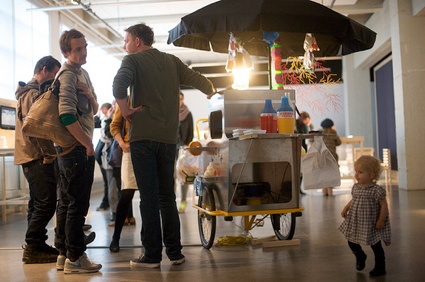 Unfold, Kiosk, MU Eindhoven, 2011. Photo by Boudewijn Bollmann
Unfold, Kiosk, MU Eindhoven, 2011. Photo by Boudewijn Bollmann
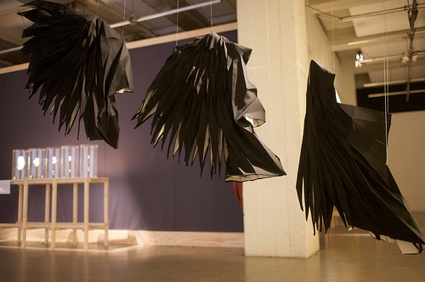 The T-Shirt Issue, Muybridge Project – MU Eindhoven, 2011 – photo by Boudewijn Bollmann
The T-Shirt Issue, Muybridge Project – MU Eindhoven, 2011 – photo by Boudewijn Bollmann
After the Bit Rush is a joy to visit. The show is obviously very entertaining and at times even poetical but it also manages to bring into one exhibition space some stunning examples of what the ‘post digital’ means for design tools, for the fabrication and distribution, for the way we embrace and participate in design, and the impact it will have on fashion, entertainment, even medical training.
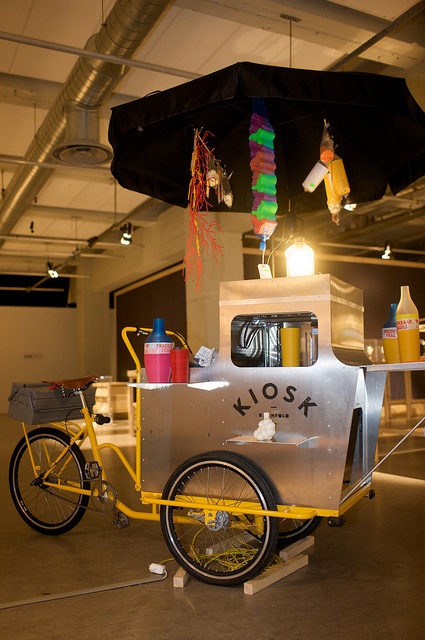 Unfold, Kiosk, MU Eindhoven, 2011. Photo by Boudewijn Bollmann
Unfold, Kiosk, MU Eindhoven, 2011. Photo by Boudewijn Bollmann
Kiosk is probably the best introduction to the post-digital idea. Inspired by Bruce Sterling’s sci-fi story of the same name, KIOSK sends you in a not so distant future when digital fabricators are so ubiquitous that even the owner of the mobile stall up your street can custom make on the spot whatever you order: new frames for eyeglasses, the missing bit of a broken high heel, etc. They can even download (illegally), customize if so you wish and 3D print for you a Juicy Salif squeezer.
For the designers at Unfold, the project also offers the opportunity to reflect on the impact that new technologies have on design: How does this scenario challenge our perception of authorship, originality, design and what is the role of the designer when goods are moved around in the form of digital blueprints and appropriated in ways beyond our control?
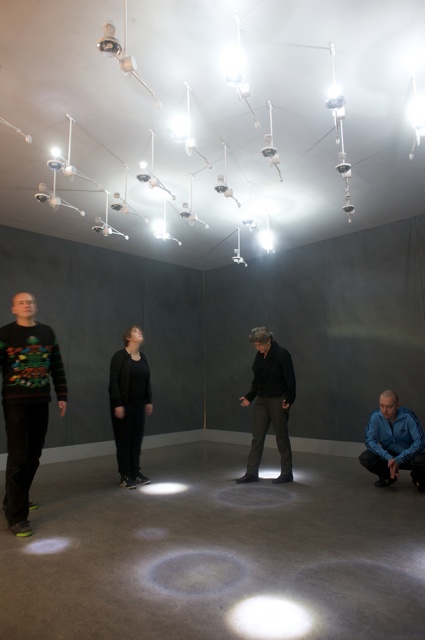 Troika, Falling Lights – MU Eindhoven, 2011. Photo by Boudewijn Bollmann
Troika, Falling Lights – MU Eindhoven, 2011. Photo by Boudewijn Bollmann
Troika placed LED bulbs on metal arms above polished crystal lenses; as each bulb slides away from the lens, a light beam is split into a circular pattern that resembles rain drops falling from the ceiling onto a wet surface. The whole installation is even more mesmerizing in reality than in the video above.
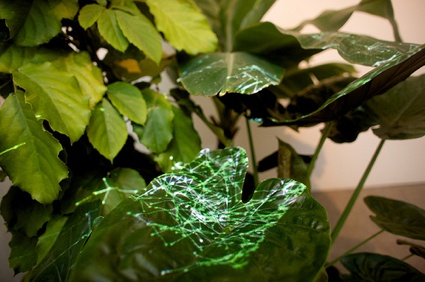 EDHV, Digital Fungus – MU Eindhoven, 2011. Photo by Boudewijn Bollmann
EDHV, Digital Fungus – MU Eindhoven, 2011. Photo by Boudewijn Bollmann
EDHV‘s Digital Fungus evokes organic behaviours too. As soon as the Digital Fungus finds light, it starts producing a colony. Anything moving around will make it jump to another area where it will start growing again. Once the light is gone however, energy is drains out and the organism slowly dies.
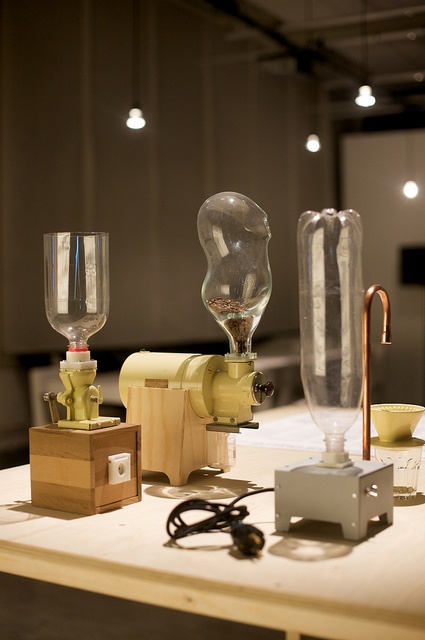 Thomas Lommée, Open Structures – MU Eindhoven, 2011 – photo by Boudewijn Bollmann
Thomas Lommée, Open Structures – MU Eindhoven, 2011 – photo by Boudewijn Bollmann
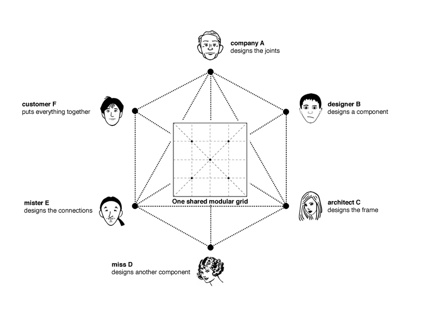 Thomas Lommée, Open Structures
Thomas Lommée, Open Structures
Thomas Lommée designed Open Structures as a kind of collaborative Meccano. The shared modular construction system allows people to build anything from a chair to a whole house, using the parts already available and adding their own when necessary.
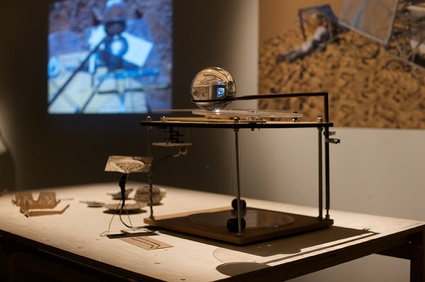 Markus Kayser, Sun Cutter, 2010 – MU Eindhoven, 2011 – photo by Boudewijn Bollmann
Markus Kayser, Sun Cutter, 2010 – MU Eindhoven, 2011 – photo by Boudewijn Bollmann
In August 2010 Markus Kayser packed his solar-powered, semi-automated low-tech laser cutter in a suitcase and brought it to the Egyptian desert. The Sun Cutter harnessed sun rays through a glass ball lens to ‘laser’ cut 2D components using a cam-guided system. The pair of sunglasses made with the Sun Cutter look half machine-made, half hand-made due to the crudeness of its mechanism and cutting beam optics, alongside variations in solar intensity due to weather fluctuations.
The designer’s following work used another element found in deserts: sand. When heated to melting point and allowed to cool silicia sand solidifies as glass. The process, called sintering, is central in 3D printing or SLS (selective laser sintering). The Solar-Sinter uses thus the sun’s rays instead of a laser and sand instead of resins to make glass objects.
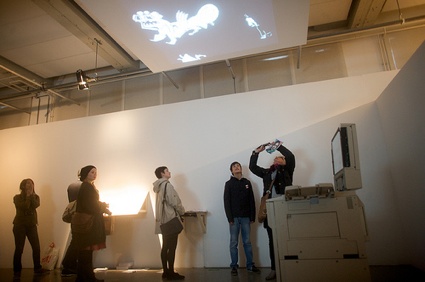 Tim Knapen, Godmode, 2007 – MU Eindhoven, 2011. Photo by Boudewijn Bollmann
Tim Knapen, Godmode, 2007 – MU Eindhoven, 2011. Photo by Boudewijn Bollmann
Tim Knapen‘s Godmode is a hacked photocopier that animates any creature visitors draw on a sheet of paper. As simple as that. You grab a pen, sketch a character on a piece of paper, place the drawing under the photocopier lid, press ‘copy’, and 5 seconds later, your creature is dancing above your head among the creatures that other visitors created.
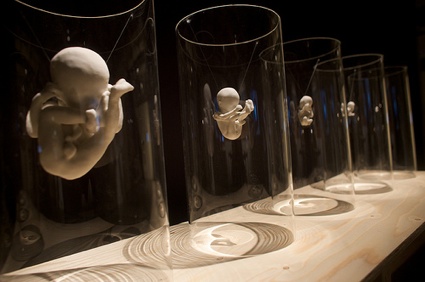 Jorge Lopes dos Santos, The Foetus Project – MU Eindhoven, 2011. Photo by Boudewijn Bollmann
Jorge Lopes dos Santos, The Foetus Project – MU Eindhoven, 2011. Photo by Boudewijn Bollmann
Ok, this one makes me feel super uncomfortable. Jorge Lopes dos Santos collaborated with a paediatric cardiologist at Imperial College to turn data from ultrasound, CT and MRI scans into physical models of foetuses. The designer believes that the models will help train doctors and provide emotional support for parents who have children born with deformities.
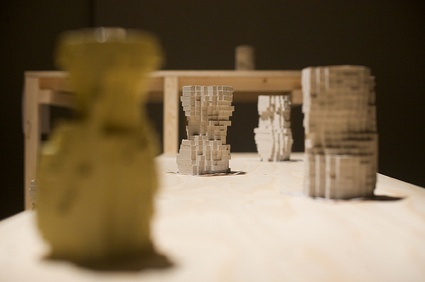 Julian Bond, Pixel Mould Machine, 2010 – MU Eindhoven, 2011 – photo by Boudewijn Bollmann
Julian Bond, Pixel Mould Machine, 2010 – MU Eindhoven, 2011 – photo by Boudewijn Bollmann
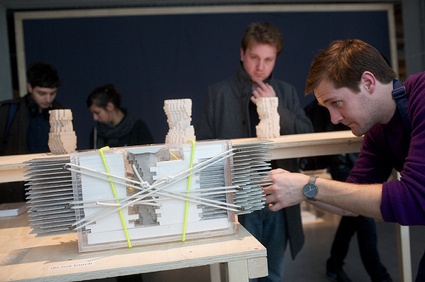 Julian Bond, Pixel Mould Machine, 2010 – MU Eindhoven, 2011 – photo by Boudewijn Bollmann
Julian Bond, Pixel Mould Machine, 2010 – MU Eindhoven, 2011 – photo by Boudewijn Bollmann
Back to safe design territory with vases! Julian Bond‘s Pixel Mould Machine produces vessels using a single mould made up of over 1300 individual plaster sticks. The sticks can be individually reconfigured to create one-off clay vases.
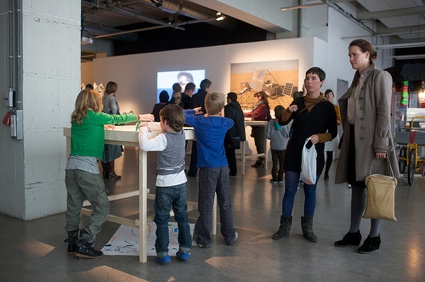 After the Bit Rush – MU Eindhoven, 2011 – photo by Boudewijn Bollmann
After the Bit Rush – MU Eindhoven, 2011 – photo by Boudewijn Bollmann
More images in MU’s flickr set and in mine.
After the Bit Rush, Design in a Post Digital Age was curated by MU, in collaboration with Lucas Maassen and Unfold. It remains open until December 23, 2011 at MU in Eindhoven.
